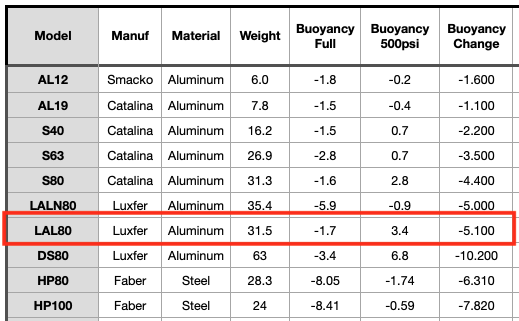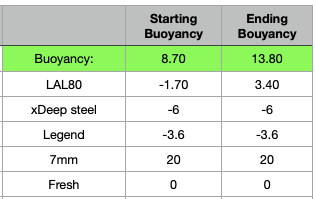Buoyancy Basics
Buoyancy, when you strip away the scientific discussions that involve the concepts of water density and displacement (Archimedes' Principle) and gravity and volume and upward force and temperature and humidity and who knows what else, is at the end of the day about managing weight. What makes it difficult underwater is that the variables I mentioned above change minute by minute...literally. There is no point in understanding the nuances of the science until you have the proper weight for ONE situation where buoyancy is critical. Ignore everything else at the beginning. Yes everything, ignore your breathing, ignore placement, ignore ditchable or not ditchable, ignore it all. There is one point and one point only you need to get started:1. The minimum weight you need to stay at 15ft of depth
But what about your ability to descend at the beginning of the dive! Recreational diving involves a single tank of gas...the amount of weight you need is going to ALWAYS be more at the end of the dive than the beginning of the dive because the only material variation in weight is the REDUCTION in weight from breathing the gas in that one tank.
Why is too little bad?
Too little generally results in one of two bad situations (or both):- You cannot descend (without some external force like duck diving) - which means your dive can't start
- You cannot stay submerged at a depth of your choosing - which means physical damage to you and even death
Why is too much bad?
Too much generally results in one of two bad situations (or both):- Descend too quickly - which means physical damage to you and even death
- Unable to ascend - which means physical damage to you and even death
How do I know how much is optimal?
You need to calculate the amount you need to stay below the surface at the end of the dive.Unfortunately...you were likely taught the fast way of doing a weight check...the "pre-dive" check.
Quick and dirty pre-dive check method
You probably know this one...1. Put all your equipment on and jump in the water and remove all air from your BCD
2. If you are wearing a wetsuit, flush it so no trapped air bubbles. brrrrrr
3. Release all the air from your lungs and you should slowly sink
4. When you breathe in and use 50% of your lungs (normal breath), the top of your head should be poking out of the water
5. When you take a full breath the water should be at eye level
6. Repeat....you should be a cork going up and down
But hold on a second...won't I consume (lose) weight from the gas I breathe on the dive? Then the above check doesn't take into account the weight of that gas at the end, and I'm going to be under weighted! Correct....now you see why it is at best...a general approximation. To use this method properly you have to know the weight of your planned gas consumption. Example: 2500psi of Air in an Aluminum 80 is ~5 pounds because maths.

Proper post dive check method
(Note: You don't have to go to 15ft...if you can stay neutral at say 5ft in a local pool...that works too. And don't be doing this by yourself...you are at the minimum reserve pressure and under water. Not a great combo when faffing about.)1. Descend/Ascend to 15ft with ~500PSI (or whatever ending pressure you typically want to have at the end of your dive)
- This could be by starting with a nearly empty tank and descending to 15ft
- This could be ascending to 15ft after your dive is over and purging air in your tank until you reach your terminal pressure
3. Are you staying easily neutral? Rising a little when you breathe in and sinking a little when you exhale.
If so...that's the weight you need. What if I change my wetsuit thickness, or my tank size, or my regulators or my BCD or my....whatever. Yup...gotta do this all over again! Well, that sucks...there has got to be a better way.
Using maths to estimate with accuracy
What you'll need are:- A body of water like a pool
- A fish weight scale
- Some assorted weights
1. Put on a bathing suit and jump in (assuming you can't be naked) and hold weights or put on a weight belt until you slowly sink in an upright position. This is your personal natural buoyancy and the amount of weight you need to overcome it. Everyone is different...measure yourself.
(For Me: effectively 0 lbs)
2. Put on your exposure suit, nothing else, and jump in...put weights on a weight belt or hold them in your hands or whatever until you slowly sink.
Subtract #1 from this number, and this is the positive buoyancy of your exposure suit.
(For my 7mm: 20 lbs / For my 3mm: 6 lbs)
3. Attach each of your equipment pieces individually in turn to the fish scale like your BCD, regulators, etc and then get in the water (shallow end of pool) or use a dock (pond/lake/ocean) and use the fish scale to measure either their:
Negative buoyancy: you did not need to add weight, and it's pulling the fish scale down (measuring lbs weight)
Positive buoyancy: you had to add weight because it was floating
4. Record these somewhere (maybe excel?) and do some maths

If I use 14lbs I will be perfectly weighted at my safety stop and 6lbs over weighted (8.70 - 13.80) at the start of the dive. This is more than I want to have at the start of my dive...but it's the END of the dive that matters...not the beginning.
What about salt water?
Technically the buoyancy in salt water changes all weight measures...but you can approximate by adding 5 or 6 lbs of positive buoyancy if you don't want to re-weight everything, which would be impractical if you were on holiday.Okay...now I know my weight need...how much of it should be ditchable? Glad you asked...
